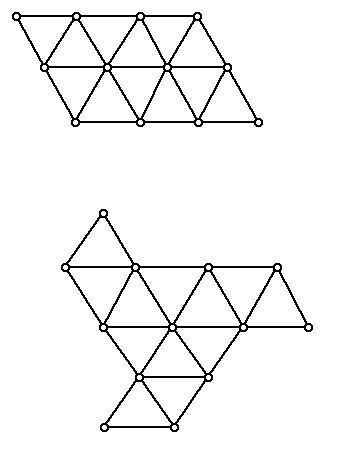
Figure 1
Folding Clusters of Equilateral Triangles
Prepared by:
Joseph Malkevitch
Department of Mathematics and Computer Studies
York College (CUNY)
Jamaica, New York
email:
malkevitch@york.cuny.edu
web page:
http://york.cuny.edu/~malk
Some recent research work that I was engaged in lead me to these two diagrams which are clusters of equilateral triangles. All the triangles are meant to be equilateral but they may be off a bit. If you want "perfect" equilateral triangles for this kind of work you can purchase them under the name of Polydrons, Jovotoys, or other competitors of these two "brands."
My thoughts were inspired by a recent paper of G. C. Shephard, a distinguished British geometer. He observed that it is possible to fold the top cluster of triangles (Figure 1) to the non-convex solid obtained by putting a regular tetrahedron "pyramid" on each face of a regular tetrahedron. Tetrahedra have four faces, and each pyramid has 3 triangles, so we will need 12 triangles to accomplish this. I was somewhat surprised when I discovered that the second cluster of triangles in Figure 1 also folded to the same solid.
You and your students might enjoy "playing" with ideas that grow out of folding these two shapes. Note that technically these are not nets because there are interior vertices in the pattern that gets folded. However, the only fold lines are those in Figure 1.
Clusters of (regular) squares assembled edge-to-edge are called polyominoes. The names of the equivalent ideas for equilateral triangles and regular hexagons are polyiamonds and polyhexes.
Reference:
Shephard, G. C. (2013). Regular Polyhedral Clones. The Mathematical Gazette, 97 (540), 421-429.
